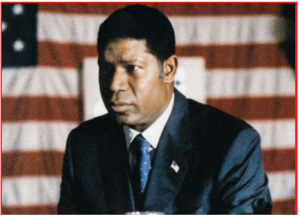FOCUS
#14
WHAT IF BARACK OBAMA WAS ELECTED THANKS TO THE SERIES “24”?
In summary : Presidents who appear in American feature films and series generally look like the ones who were in office in the 20th century, namely white. However, since the 1990s, black presidents have increasingly been present in people’s imagination. For example, David Palmer in the series “24”, who reached a widespread audience, was brought into American homes and public life, contributing along with other popular black icons to the popularity of Barack Obama.
Ethno-racial minorities in the United States are grossly underrepresented in the political class. Only one black president has been elected in the American history and the current U.S. Congress count only 57 black representatives out of 535.1 However, the film industry, and in particular Hollywood, has been developing an imaginary world that is more diverse than the institutional reality. Indeed, the first black president in a film was James Earl Jones in “the Man” (1972) in the aftermath of the American civil rights movement.

President Dilman in the Man (1972)
However, it was not until the late 1990s that American television featured such a character, namely David Palmer in the series “24”.
THE U.S. PRESIDENTS, BETWEEN FICTION AND REALITY
In Hollywood, most presidents are portrayed in realistic feature films and series. This genre deals with its characters in an empirical way, blurring the line with reality. The settings are authentic and not extraordinary, for instance a business office.
According to U.S history specialist Károly Pintér, these fictions work as self-fulfilling prophecies. Indeed, the only people who actually conform to the ethno-racial, social, or physical norm of the presidents that appear on screen are effectively elected in the real world.3 Thus, almost all presidents are white, middle-aged men with English-speaking surnames, an imposing presence and an idealized morality, such as President Marshall (Harrison Ford) in “Air Force One” (1997) or President Whitmore (Bill Pullman) in “Independence Day” (1996). According to Pintér, this closeness between fiction and reality is even more significant considering that the political sphere and Hollywood are closely interconnected. Indeed, some scriptwriters sometimes become advisors to candidates, and vice versa. For instance, Eli Attie is a former speechwriter for President Clinton who later became a screenwriter. As a matter of fact, one of Barack Obama’s speech inspired him to create the character of Matt Santos, a young senator who later was elected president in the series “The West Wing” (2005).
DAVID PALMER, A CULTURAL ICON THAT BURSTED INTO THE SCREEN
“24” was launched in 2001 and is considered as ultra-realistic since it has been filmed in real time. For example, a car ride in an episode takes as long as an actual car r across the city. President Palmer’s in the series appears from 2001 to 2006, several years before Obama’s election.
Although President Palmer (played by Dennis Haysbert) is black, his character never completely subverts the normative fictional image of what an American president is supposed to be, namely a courageous and honest man. Just like Obama, he speaks with a so-called “neutral” accent and is not a former civil rights activist. They both are not so different from how the conventional American president should, meaning “affable and neat, overly polite, a gifted speaker with a smooth baryton voice to top it off” according to Joshua Alston, historian at Leeds University. Moreover, according to communications specialist Erika Molloseau (Denison University), both men are each “educated, poised, almost too good to be true,” and embody an “alternative” image of “African-American masculinity.”However, Palmer’s character has gradually outgrew the show and stepped into the public sphere. Thus, when the actor Dennis Haysbert bumps into his fans, they usually call him “President” and ask him to run for the elections. At a dinner hosted by the Congressional Black Caucus Foundation in 2006, the actor took part in a Q&A session as if he were a state representative and adressed prison reform and drug rehabilitation. At some point, many bloggers even promoted the slogan “Palmer for President”.

President Palmer in “24” (2001-2006)
In 2015, 89% of the people who watch the series even stated that Palmer’s character seemed reliable and that they would be happy about him being in charge of the country. The enthousiasm regarding a black president goes beyond David Palmer: for instance Morgan Freeman in “Deep Impact” (1998) is often described as an example of how presidents should be in real life.10According to researcher Maurice Ronai, these fictional presidents have a far-reaching impact, not only because of their skin color, but also because of their personal integrity, composure, restraint.
However, since the late 1990s, a wide range of African-American icons, including David Palmer, have not only normalized, but even made desirable, the idea that a black man could be elected president of the United States. Historian and author of “L’Amérique de Barack Obama” (Demopolis, 2008) François Durpaire, considers that images and representations play a significant part, stating that “there would probably be no President Obama without these fictional heroes”.
L’Observatoire des images, créé en 2021, est le premier organe associatif regroupant celles et ceux qui s’intéressent au rôle des images au cinéma, à la télévision, dans les jeux vidéos et dans les publicités, notamment sur Internet. Convaincu.e.s que les images peuvent figer les représentations et enfermer dans des stéréotypes, ou au contraire permettre l’émancipation et ouvrir le champ des possibles, les partenaires de l’observatoire se sont réunis pour réfléchir et agir ensemble, que ses membres travaillent dans la production, la distribution, le financement, la communication, la recherche, les institutions…
Les objectifs de la coalition sont notamment de : sensibiliser les pouvoirs publics, les professionnels et le public ; développer la recherche sur la réception des images et mettre en lumière les travaux existants ; agréger et soutenir les pratiques professionnelles ; valoriser les projets et les équipes soucieux de lutter contre les clichés.
– Rejoignez-nous : observatoiredesimages.org!

